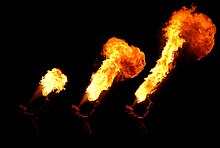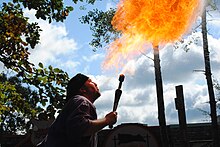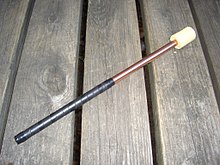User:ToddLinhoff/Spherex xbox 5.1 surround sound system







Fire breathing is the act of creating a fireball by breathing a fine mist of fuel over an open flame. Proper technique and the correct fuel create the illusion of danger to enhance the novelty of fire breathing, while reducing the risk to health and safety. When using the correct fuel, it will only light when sprayed into a fine mist increasing the surface area of the fuel so that the fuel/oxygen/heat ratio is balanced enough to cause combustion.
Safety
[edit]Performing[1] with fire has inherent risks. Having an actively spotting trained safety with a fire blanket[1] is an appropriate best practice when fire breathing.[1][2]
Flash point
[edit]To increase safety, fire breathers must avoid highly combustible fuels such as alcohol, spirit-based fuels, and most petrochemicals, instead using safer combustibles with a higher flash point (>50 °C). Due to its relatively safe (~90 °C) flash point, paraffin, or highly purified lamp oil, is the preferred fuel for fire breathing. Although corn starch has been cited as a non-toxic fuel, the hazards of inhalation increase the potential risk of lung infections.[1][1][1][1][1]
Wind
[edit]Determining wind direction is extremely important when fire breathing. To determine the wind direction a fire breather will watch the flame on their torch and only breathe downwind. Breathing fire in high wind, or unpredictable wind, is not recommended.[1]
Self-ignition
[edit]With fire breathing, the greatest risk of self-ignition (lighting the clothing or costume) comes from using lower flash point [1]fuels (like white gas) on the fire breathing torch. Untreated 100% cotton clothing is adequate for most experienced fire performers[1]. Polyester clothing is not recommended, as it can easily melt, drip[1] and stick to the skin when ignited. Flame-resistant treated cotton (i.e., Westex's INDURA fibre) or synthetic aramid-type fibre (i.e., DuPont's NOMEX fibre) long-sleeve shirts and trousers are recommended for fire performers (in general) who use the more combustible fuels on their torches.[1]
While not necessary when using the proper fuel[1], fire breathers will sometimes carry a cloth to wipe their mouth between fireballs[1] to remove excess fuel from their mouth and neck. Facial hair can be an issue when using certain fuels. More combustible fuels evaporate at lower temperatures and have a lower flash point[1]. The constant off-gassing of vapours increases the risk of combustion.[1]
Health
[edit]When fire [1]breathing with the wrong fuel, or an improper technique is used, fire breathing can increase the risk of:
- Death[1]
- Severe burns[1]
- Dental problems[1]
- Fuel poisoning[1]
- Lipid pneumonia[3] or acute respiratory distress
- Dry cough[1]
- Headache, dizziness, drunken ill feeling[1]
- Nausea, diarrhea, vomiting, stomach ache[1]
- Dry mouth/cotton mouth[1]
- Dry skin and topical heat burns[1]
Inhalation
[edit]The [1]inhalation of paraffin in fire breathing can lead to very severe exogenous[1] lipid pneumonia with potentially fatal side effects.[3] This is true[1] even when the atomized (misted) breath is not on fire.
Lamp oil will coat the pulmonary[1] tissues causing severe inflammation, preventing proper oxygen absorption, and carbon dioxide[1] expelling.[4] Improper technique can be fatal.
Fuel risks
[edit]The best fuel[1] to use for fire[1] breathing[1] is[1] "ultra[1] pure[1] clear[1] unscented lamp oil", also known as liquid paraffin wax or mineral oil, which is difficult to find in most countries around the world. Improper technique using the proper fuel can still risk mist inhalation, which may cause symptoms such as headache, sinus infection, and lipid pneumonia. If swallowed it can trigger peristalsis (diarrhoea).
Corn starch and powdered sugar[1] (50:50) works as well, if you can stand the powder in your mouth, though it can be inhaled and lead to health problems.
Fuels that are considered especially dangerous include:[1]
- Ethanol can be absorbed into the blood stream without drinking. Thus attempting fire breathing with ethanol can cause intoxication.[1]
- Methanol (used with many colored flame recipes) has a variety of entry vectors and can cause blindness or neurological disorders.[1]
- Very low flash point fuels like naphtha, butane, and propane can create a condensed vapor build-up in the oral cavity leading to internal combustion, damaging the mouth or lungs. Naphtha also is quite carcinogenic, and performance careers built on using it entail a high risk of mouth cancer.[1]
- Common fuels like gasoline and kerosene often contain carcinogenic additives or refining by-products, such as sulfurated compounds, or benzenes.[1]
In modern culture
[edit]Contemporary fire arts culture and fire breathing
[edit]In the early 90's Chris Valagao of Zimmers Hole learned to breathe fire from a member of Black Diamond (KISS tribute Band), who had been taught to breathe fire by Gene Simmons. In 1995 Chris Valagao taught Napalm Dragon to breathe fire. After teaming up with a group of circus[1] performers, Napalm Dragon incorporated fire breathing with electronic music and urban tribalism, ushering in the contemporary fire arts culture in Vancouver, British Columbia, Canada. Working with various community minded fire performers he collaborated with various groups including The Spiral Tribe in 1996, fostering the fire arts culture and fire dancing culture throughout the BC region. As the Internet gained its ground to communicate over vast distances, the meme of the contemporary urban tribal fire dancing culture spread from its Polynesian, Thai, and Australian[1] influences to the contemporary electronic music scenes of the world. Fire breathing flourished in Canada and North America due to the high quality of fire breathing fuel and ease of access to it.
Black metal
[edit]The heavy metal subgenre known[1] as black metal has been known to feature fire breathing among its imagery. While heavy metal has a history of including fearsome stunts and sideshow spectacles, the most likely originator of fire breathing in black metal culture was Quorthon, frontman of the founding Swedish black metal band Bathory. In a number of famous promotional photos, all dating from before 1988, Quorthon is seen spewing plumes[1] of fire. According to bathory.se, the only official Bathory website (link no longer available), Quorthon ceased this spectacle due to overblown media attention to his image rather than music[1].
As the Scandinavian black metal scene of the[1] 1990s expanded, a number of Norwegian musicians began[1] to produce similar promotional photos of fire breathing[1], most likely in emulation or tribute to the Bathory photos. An example of this can be seen at www.peterbeste.com featuring Frost of the bands Satyricon and 1349 performing the stunt in a cave in Nesodden, Norway. A number of black metal music videos have featured examples of fire breathing as well, including Immortal's "Call of the Wintermoon" and Satyricon's "Mother North".
World record
[edit]On 14 March 2007, the Dutch student[1] association T.S.V. D'Artagnan set a new world record for simultaneous fire breathing. A total of 113 people breathed fire together. On 15 October 2008, another Dutch student association[1], s.v. Intermate at the Eindhoven University of Technology, increased the world record for simultaneous fire breathing with as many as 267 people.[5] On 23 April 2009 this record was succeeded by 293 students in the Dutch city of Maastricht as part of the Ragweek charity event.[6]
In August 2007 the record for the biggest fire breathing pass was set at the Burning Man festival in the Black Rock Desert, Nevada. A single breath was passed to 21 people before the flame went out.
Tim Black (Australia) of Androgen Fire Art blew a flame to a height of 5.4 meters (17 ft 8.5 in) on the set of Guinness World Records at Seven Network Studios, Sydney, New South Wales, Australia, on 19 June 2005. He later equaled this feat on the set of CCTV in Beijing, China (2006). In August 2007 Tim Black returned to the set of CCTV in Beijing, China, and broke his existing record by blowing a flame to a height of 7.2 meters (23.62 feet). This is the current record as published in the 2009 Guinness Book of World Records.
Fire artist Flambeaux, also known as Chris Reilly, holds the world record for the most fire blows from one mouthful of fuel, 25.[7]
In fiction
[edit]- David Almond's book The Fire-Eaters is the story of a young boy living in Northumberland who gets to know a local performing fire eater.
- Inkheart (Cornelia Funke) character Dustfinger is a talented fire-eater and fire-breather. According to Resa everyone in his world knew his name; he is alternatively called the fire-dancer, because of his unparalleled talent.
- In Skins series 3, episode 5, JJ swallowed a spliff, feigned choking, took a swig from the bottle of supposed urine and blew a fireball with a lighter. The urine was, in fact, paraffin JJ had planted eight months previously in preparation of the illusion.
- In the anime and manga Inuyasha, Renkotsu of The Band of Seven uses oil to breathe fire.
- The title character of Xena: Warrior Princess is capable of breathing flame at her opponents using a mouthful of alcohol and a nearby source of fire.
- In the sci-fi horror film "Pitch Black" the character Paris breathes fire using his flask and lighter as a last stand against the monsters before succumbing to his injuries.[1][1][1][1][1][1][1][1][1][1][1][1][1][1][1][1][1][1][1][1][1][1][1][1][1][1][1][1][1][1][1][1][1][1][1][1][1][1][1][1][1][1][1][1][1][1][1][1][1][1][1][1][1][1][1][1][1][1][1][1][1][1]
See also
[edit]References
[edit]This article includes a list of general references, but it lacks sufficient corresponding inline citations. (April 2009) |
- ^ a b c d e f g h i j k l m n o p q r s t u v w x y z aa ab ac ad ae af ag ah ai aj ak al am an ao ap aq ar as at au av aw ax ay az ba bb bc bd be bf bg bh bi bj bk bl bm bn bo bp bq br bs bt bu bv bw bx by bz ca cb cc cd ce cf cg ch ci cj ck cl cm cn co cp cq cr cs ct cu cv cw cx cy cz da db dc dd de df dg dh di dj dk dl dm Pele "Fire Breathing", 2002. Retrieved on 2010-10-18.
- ^ NAFAA "NAFAA Performer Safety Guidelines. (Revision 2.1)", 2010-7-5. Retrieved on 2010-10-18.
- ^ a b I. Weinberg and Z. G. Fridlender "Exogenous lipoid pneumonia caused by paraffin in an amateur fire breather -- Weinburg and Fridlender 60 (3): 234", Occupational Medicine, 2010-3-22. Retrieved on 2010-8-22.
- ^ A. Gondouin, et. al. "Exogenous lipid pneumonia: a retrospective multicentre study of 44 cases in France", European Respiratory Journal, 1996, 9, 1463–1469. Retrieved on 2010-8-22.
- ^ "Wereldrecord vuurspuwen voor TU/e-studenten". Omroep Brabant. 15 October 2008. Retrieved 20 February 2010.
- ^ "Maastricht: Studenten brechen den Rekord im Massen-Feuerspucken". BRF. 24 April 2009. Retrieved 20 February 2010.
- ^ [1]
External links
[edit]- Fire Breathing Basics by Pele c/o Home of Poi, 1996, retrieved July 22, 2010
- Androgen Fire Art World Record Fire Performance Group
- North American Fire Arts Association
- Fire Breathing Arts Worldwide resources for fire breathing trainers & performers
- Fire breathing video Amateurs breathing fire
- Fire Breathing Safety Advices by Oddballs.co.uk
- Lamplight Farms Ultra-Pure Lamp Oil? by Lamplight Farms, January 10, 2002, retrieved September 25, 2006
- Fire Breathing and Fire Eating FAQ by Juggling Information Service, 1996, retrieved September 25, 2006
- Tedward Tedward, part of Red Swan Entertainment
